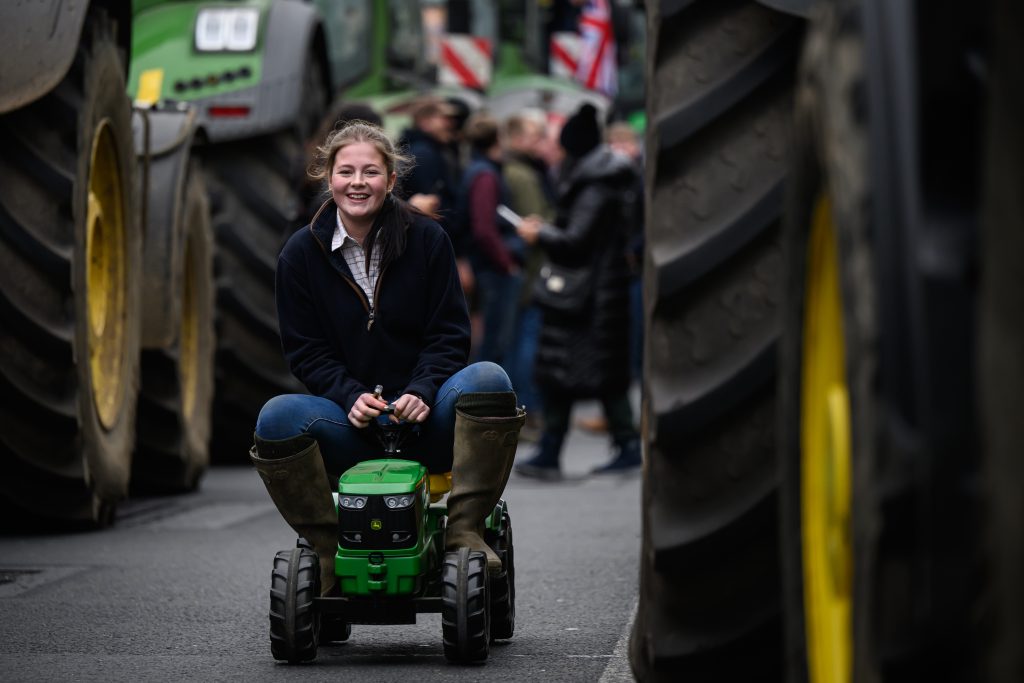Win CENS ProFlex DX5 earplugs worth £1,149 – enter here
The key issues of shotgun restoration
Shotgun restoration: Shotgun restoration requires time and money.
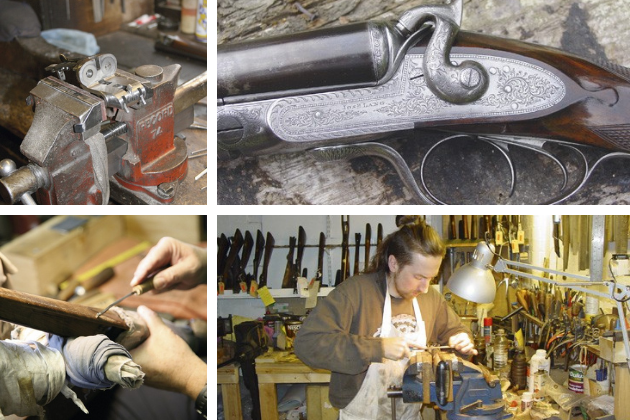
In the old days of the gun trade one used to see a lot of ‘do-ups’ – older guns restored to pristine (or near pristine) condition by properly trained gunsmiths. The costs involved tended to be modest: artisan work was cheaper then, and there were more competent gunsmiths around – people who had done their time at the bench with smoke lamp, file, and gauge.
As gunsmiths become thinner on the ground, their time is more valuable. Which has big implications for shotgun restoration. (If you’re interested in gun case restoration, read here.)
You may have an heirloom or ‘old friend’ where money is not the first object. Then you will probably go ahead anyway and your main consideration will be getting the right people in to complete the job.
Shotgun restoration skills
So what should you look out for? There is considerable variation in quality of work these days, especially when it comes to skills such as barrel blacking and stock finishing. When you get into the realms of barrel making and repair, action and trigger, and even restocking, it becomes even more difficult to find good work at a fair price. One must go by personal recommendation or with someone whose work you know. One man might be great at wood but not so hot on triggers.
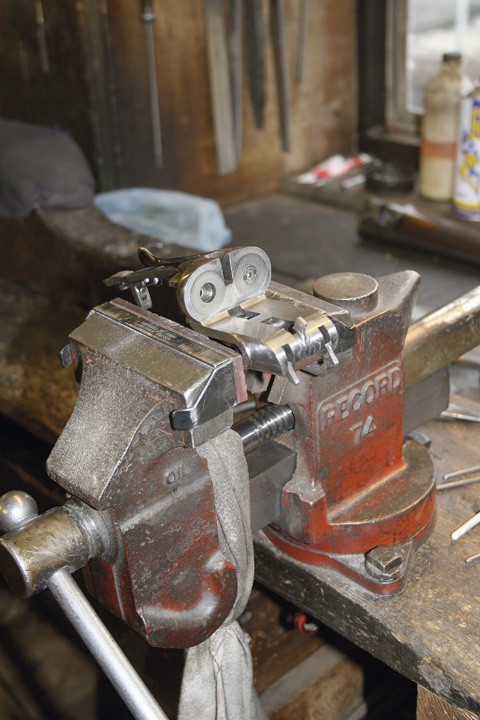
There are fewer artisan gunsmiths working today compared with a generation ago, which has pushed up costs.
Shotgun restoration will cost you
It costs more or less the same to work on a £500 side-by-side these days as a £5,000 or £50,000 gun. So if you are buying a firearm to restore, you must be aware that restocking it might cost as much as £6,000 from a London apprenticed craftsman, and double that from a London maker who might put the work out to him anyway. Similarly, with barrels you might pay a first-class tradesman £6,000-plus for re-barrelling a side-by-side, more for an English over-under, and £2,000 for good quality sleeving, where the tubes are properly struck up and the original balance of the gun replicated.
However the modern world has brought some interesting new possibilities. Nigel Teague is renowned for his choke work – he can retro-fit thin wall chokes to vintage guns and restore or add missing constriction. He can also fit liners to Damascus tubes, which become an alternative to conventional cut-the-barrels-off-at-the-chambers sleeving. His process does not interfere with surface finish and rib, though it may add slightly to weight.
The laser welding offered by Carr’s Welding Technologies Ltd is impressive. Micro welding techniques have been developed where pitting and other flaws in gun metal (and many other things such as the cutting edges of tools) may be repaired by ground-breaking methods that use very localised laser heat. Pitting that might have ruined an otherwise great old gun can now be dealt with at relatively modest cost.
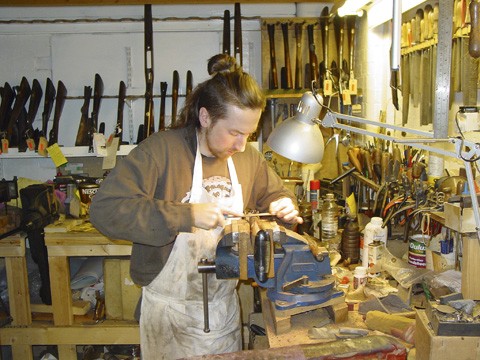
Stock measurements can be changed easily as long as there is enough quality in the wood.
How much work?
There are other important considerations when assessing any candidate for shotgun restoration. Perhaps most importantly, think about proof and barrel wall thickness. Is the gun in proof? If so, by how much? When your gun is lapped out to remove pitting and polished/struck up for blacking, it is nice to see something significantly over 20 thou’ in the barrel walls themselves when the work is finished. You may have to bite the bullet of putting the gun through reproof too. Lapping a gun out to remove pitting, meanwhile, can substantially affect its material dimensions. Even lifting small dents and polishing inside and out in preparation for blacking may remove several thousands of an inch, so beware.
Stocks
In terms of stock, I like to see guns with their original finish – and I have never minded seeing a few hard-won bumps and bruises. Any shotgun restoration should be sympathetic. It is a mistake to overdo it – unless you completely rebuild a gun, which is what Ken Duglan used to do when he owned Atkin, Grant & Lang. Ken would acquire suitable candidates for special treatment. He would vacuum-soften the action, a relatively new process that allows for re-engraving if required and re-colouring with less effect on the structural integrity of the metal. He would then restock, re-barrel, and replace every pin and swivel, creating what was, in effect, a new gun. He was able to keep the costs down by having an experienced team working for him.
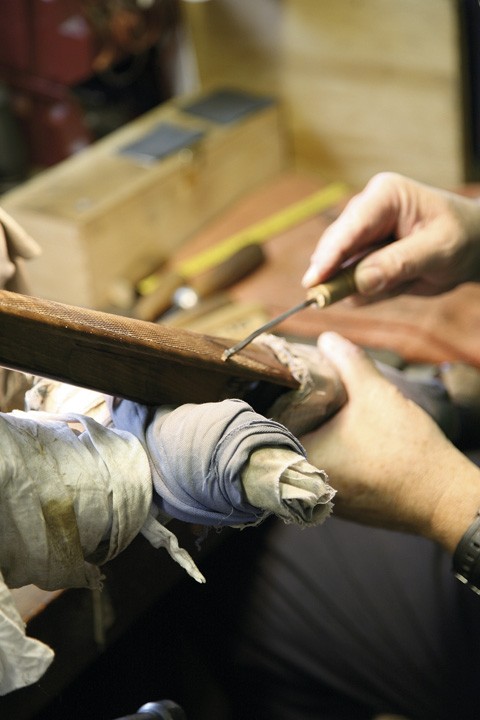
Reviving damaged chequering is a crucial part of any successful restoration.
What amateurs should look out for
Amateurs are often caught out by not assessing the gun well enough initially. If there are insufficient funds to allow for restocking, you must examine the stock minutely, preferably with locks off the action if it is a sidelock. You should also check that the fore-end is in reasonable condition – fore-ends are almost as expensive to replace as stocks, although chips down the side can often be sorted relatively easily, as can oil absorption issues. However, I would not accept any butt that was cracked at the head or hand. A missing toe, though, is no big deal. (Read here for tips on restoring gun stock shine.)
Stock measurements may usually be changed quite easily. The important thing is how much good wood there is. If you have 14 inches excluding an extension or plate, you can probably get 15 inches with a recoil pad contemporary to the gun that will still look right. Do not skimp on blacking or chequering – a great shotgun restoration job may be ruined at the final fence by inappropriate chequering. Similarly, screws with less than perfect slots are relatively easy to replace at not unreasonable cost and make a big difference to the way the finished job looks.
Many older guns are loose, or ‘off the face’ as they say in the trade. You may need to replace the hinge pin and/or cold weld the hook of the front lump (sometimes a piece of new metal is dovetailed in to replace the bearing surface). Main, ejector and top-lever springs may need replacing, as may firing pins. All these are routine jobs, as is rib removal and relaying. But the costs do add up – the £1,000 bargain can easily turn into a £2,500 bad buy.
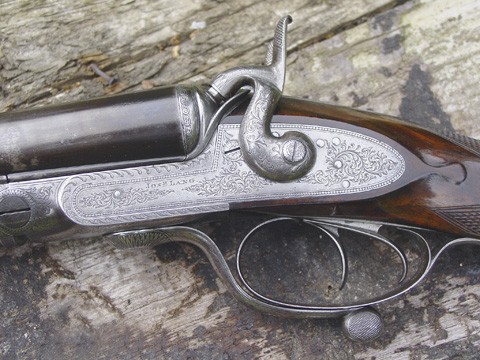
The author’s lightly restored Joseph Lang under-lever hammer gun.
Just as damaged or ugly screw heads can spoil the entire look of a gun, so can faded engraving on the rib. This is well worth enhancing if you are planning on doing your shotgun restoration properly. The same may be said of the engraving on the trigger guard and bottom plate – getting engraving picked out is much harder than it used to be, though, because not many engravers enjoy doing the work.
What guns to look out for
It is almost a necessity to get a competent gunsmith to look at any gun that takes your fancy as a shotgun restoration candidate before you buy it. Auction purchase presents special pitfalls as well as the opportunity for bargains. We are all looking for sleepers, but I would also seek guns that may appear a bit unloved, but which apart from their worn blacking, scratches and bruised timber are in essentially sound mechanical condition. These are by far the best candidates for shotgun restoration.
This article was originally published in 2012 and has been updated
Related Articles
Get the latest news delivered direct to your door
Subscribe to Shooting Times & Country
Discover the ultimate companion for field sports enthusiasts with Shooting Times & Country Magazine, the UK’s leading weekly publication that has been at the forefront of shooting culture since 1882. Subscribers gain access to expert tips, comprehensive gear reviews, seasonal advice and a vibrant community of like-minded shooters.
Save on shop price when you subscribe with weekly issues featuring in-depth articles on gundog training, exclusive member offers and access to the digital back issue library. A Shooting Times & Country subscription is more than a magazine, don’t just read about the countryside; immerse yourself in its most authoritative and engaging publication.






